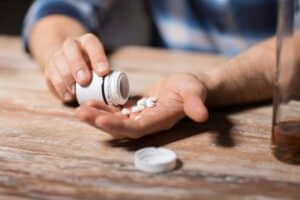Psychoactive drugs are drugs that change your mental state. These drugs can cause intoxication, which impacts your mood, perception, and consciousness.
Many legal and illegal substances contain psychoactive properties, so it’s important to know the benefits and risks associated with these drugs.
6 Types Of Psychoactive Drugs
- Depressants
- Opioids
- Stimulants
- Hallucinogens
- Marijuana
- Designer drugs

Depressants
Depressants slow down the central nervous system. They typically cause people to feel sedated and relaxed. Some people take prescribed depressants to help with sleep or anxiety. Others abuse these substances to get high.- Benzodiazepines include medications like Xanax, Valium, and Klonopin.
- Sedative-hypnotics include medications like Ambien and Lunesta.
- Barbiturates include medications like Nembutal and Luminal.
Opioids
Opioids also act like depressants. When taken as prescribed, they can help people with moderate or severe pain. When abused, they can produce feelings of euphoria and relaxation. Opioids include drugs like:- Fentanyl
- Heroin
- Vicodin
- Oxycodone
- Morphine
Stimulants
Stimulants increase brain activity. They enhance energy and alertness. Some people are prescribed stimulants for symptoms related to ADHD or narcolepsy. Common stimulants include:- Amphetamine
- Methamphetamine
- Cocaine
- Tissue damage
- Stroke
- Heart attacks
- Depression
- Insomnia
- Fatigue
Hallucinogens

- LSD
- Psilocybin
- DMT
- Peyote
- Ketamine
- DXM
Hallucinogens disrupt the communication between brain chemical systems. When abused, these drugs can result in mood problems, sensory issues, and sleep disruptions. They can also trigger hallucinations and delusions. Sometimes people experience a “bad trip.” When this happens, they may feel stuck in a panicked state for hours or days. Afterward, they may endure flashback syndromes, where they relive the terror over and over again.
Marijuana
Marijuana affects how your senses perceive the world. The THC found in marijuana can produce feelings of euphoria and relaxation, but it can also impair memory and cause coordination problems.Designer Drugs
There are many different kinds of designer drugs. Common ones include:- Bath salts
- Spice/K2 (synthetic marijuana)
- MXE
- Flakka
- W18
Self-Assessment: Am I Addicted?
"*" indicates required fields
Finding Help For Addiction
Whether you’re reading this article for yourself or someone else, there are many things you can do to fight back against addiction.
Start by:
- Cognitive behavioral therapy (CBT)
What drugs are causing problems? How have they affected your overall life? How long has the abuse lasted?
- Determining payment
Can you use your health insurance for treatment? Do you need to set up a payment plan?
- Determining additional issues
Are there any other mental or physical illnesses present? What other circumstances require support?
- Finding the motivation
Why do you want things to change? Why do you want to live a life free from addiction?
Questions about treatment options?
Our admissions team is available 24/7 to listen to your story and help you get started with the next steps.


